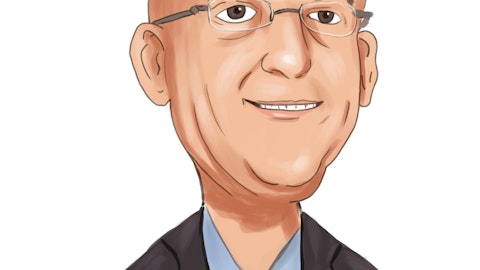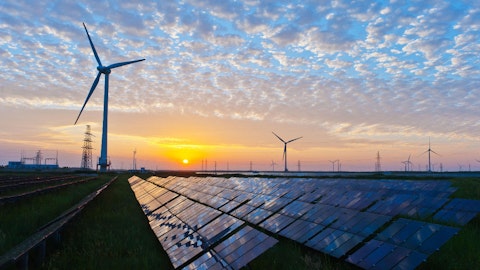Yumin Liu: In fact, I cannot really release the details of the project. For example, you mentioned Pennsylvania deal sales. In general, the smaller deals in some regions or some countries in Europe or U.S. normally enjoys a better per watt price, okay? But big utility scale sounds like a normally smaller — per watt price will be lower, okay? That’s number one, the big concept. Another one is, that the PPA price goes in normal cases very high in Europe, which in turn drives the sales price very high. You are right, the COD payment normally is $1 million to $1.1 million per megawatt in Europe or in the U.S. a little bit different, when you put the structure of that equity into it. But in Europe, it’s a very easy to say that people are offering $1 million to $1.2 million per megawatt.
That’s the typical price. And also on NTP, that could go as much as from, let’s say, use to per watt by cents, from $0.20 to $0.50. Okay? It really, really have a big rent and a wary from country to country. And also from the different functions of the solar farm. For example, in Italy, the industrial end, the NTP sales price can be as high as $300 to $400 per megawatt. Okay. No, I’m sorry, $300,000 to $400,000 per megawatt. But for farmland, it is around 200,000. And also in countries of Poland and Hungary, all those numbers can be different one the other side — on the other countries. But in general, all the average sales price go up in average.
Donovan Schafer: Okay. Right. Because it’s just sort of a lagging — it follows PPAs probably on kind of a lagging basis
Yumin Liu : Look, Donovan, another good thing is, we do have noticed that the supply chain is coming down. And we do have as we are continuously acquiring — procuring modules and we do have seen the module price comes down in the last couple of months and we forecast that starting Q2 next year, it will go further down. That will help our IPP initiative, also help driving our EPC activities more profitable.
Ke Chen: Donovan, I will add for U.S. communities solar projects, the price is much, much higher than you just mentioned here. So our — we also have community business here in U.S. so the pricing is pretty good right now.
Donovan Schafer: Okay, great. And if I can just squeeze in one last question. For the Emeren, for the team, if I recall correctly, I think, Yumin, you used to work with a couple of these guys back at Recurrent or that was before, I guess, Recurrent was required by Canadian. And you guys partnered with them back in July, not this July, but I guess it would be a year and a half ago now. So it seems like you’re pretty — you have a pretty good familiarity with them and they were kind of — I guess, maybe there’s sort of two questions on this where, one of you could just kind of remind me what the background is there that gives you some familiarity? And then two, what kind of — like there’s a sort of a good match here because, as I understand it, they kind of did this land to grab move in Italy where you can put on down small sort of deposits with the land rights owners and whatnot to kind of secure the site.
But then there are these to go from early stage to mid or late stage, you need more meaningful cash to put down for deposits, interconnection and whatnot. So what kind of cash requirements will that have? You have the healthy cash balance, but it seems like that’s part of what you’re bringing to the — part of what you are bringing to the party, if you will. So what would the cash need be there to help move forward today over the next 12 months, 24 months, kind of how are you going to frame it?
Yumin Liu: Okay. let me address your question — two, three questions separately. One is, you are right, the founder of the company and a couple of key guys in the company driving the development, finance and legal all used to work for me when I run the EMEA region for Canadian Solar. And they started the partnership with us back to 18 months ago, since summer last year. And we know them well, we absolutely trust their capabilities developing projects. The second point is that, Italy is one of the top three solar market in Europe. We’ve been thinking to go to Italy and driving or hiring a local team and build up the local structure to develop this market, very important market. And that is why to the point when we partnering with Emeren, we believe it’s better for those to join us.
So that comes to the conclusion of the acquisition. Another point is that, the Italy for Emeren’s structure, they have five DSA partnerships. DSA is really development service agreement. Literally speaking, that answers your question about cash flow. This company, Emeren, has a very unique structure of development. All the projects they have developed before we joined are located to the five DSA partners. And the DSA partners will pay Emeren based on the milestone achievements, milestone zero, one, two, three. And as such, the cash need is pretty minimal. But at the same time, they do have the need in short term, for example, for the land and sometime interconnection. They do need some cash in the short term before we turn those two to the SA partners.
And then after the acquisition, we decided not only we work with the DSA partners other four, but also we will develop internally our pipelines, which is about 500 megawatts internal pipelines on solar site and also another 500 megawatts storage pipeline. that stores 12,000 megawatt, not 500 megawatt hours, okay? So that is how meaningful we say this acquisition really is.
Donovan Schafer: Okay, great. Thank you, Yumin. And I’ll take the rest of my questions offline. Thanks guys.




